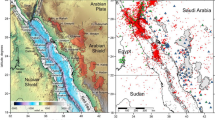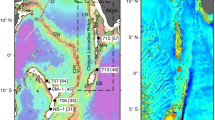Abstract
The geophysically unusual Laxmi Ridge (eastern basin, Arabian Sea) is associated with a prominent elongated negative gravity anomaly. A seismically and geodynamically constrained detailed 2D gravity modeling suggests an 11-km-thick normal oceanic crust and an asthenospheric upwarp to a depth of 35 km. We attribute the apparent thickening of the crust to a possible emplacement of an anomalous subcrustal low-density layer between 11 and 19 km depth. We hypothesize that a K-T boundary bolide impact near the Bombay offshore led to several geological events, including eruption of Deccan flood basalts. The spreading Carlsberg Ridge in the Indian Ocean and rifting associated with Deccan volcanism generated the compressive regime, which perhaps originated the Laxmi Ridge.
Similar content being viewed by others
References
Anderson DL (1982) Hot spots, polar wander, Mesozoic convection and the geoid. Nature 297:391–393
Babu Rao V (1970) An analysis of gravity anomalies over Hawaiian volcano. MS thesis (unpublished). Honolulu: University of Hawaii. pp 1–55
Birch F (1961) The velocity of compressional waves in rocks to 10 kilobars, Part 2. Journal of Geophysical Research 66:2199–2224
Brahmam NK and Negi JG (1973) Rift valleys beneath Deccan Traps (India). Geophysical Research Bulletin 11:207–237
Catchings RD and Money WD (1991) Basin and Range crustal and upper mantle structure, northwest to central Nevada. Journal of Geophysical Research 96:6247–6267
Deshmukh SS (1984) Geological and petrographic studies of the Deccan basalts flows and intercalated volcanoclastic beds encountered in drill holes in Bombay city and harbour areas. Geological Survey of India Records 113:33–51.
Flovenz OG and Gunnarsson K (1991) Seismic crustal structure in Iceland and surrounding area. Tectonophysics 189:1–17
Fyfe WS (1990) Tectonics and geochemical change. In: Sychanthavong SPH (Ed.), Crustal Evolution and Orogeny. New Delhi: Oxford & IBH Publishing. pp 193–204
GRAMOD (1981) Gravity model-fitting program developed by M/s. Paterson, Grant and Watson Limited, Toronto (unpublished)
Gurnis M (1988) Large-scale mantle convection and the aggregation and dispersal of super continents. Nature 332:695–699
Hahn A, Kind EG, and Mishra DC (1976) Depth estimation of magnetic sources by means of Fourier amplitude spectra. Geophysical Prospecting 24:287–306
Hartnady CGH (1986) Amirante basin, western Indian ocean: Possible impact site of the Cretaceous—Tertiary extinction bolide? Geology 14:423–426
Kaila KL, Tiwari HC, Krishna VG, Dixit MM, Sarkar D, and Reddy MS (1990) Deep seismic sounding studies in the north Cambay and Sanchor basins, India. Geophysical Journal International 103:621–637
Krishna VG, Kaila KL, and Reddy PR (1991) Low velocity layers in the subcrustal lithosphere beneath the Deccan Traps region of western India. Physics of the Earth and Planetary Interiors 67:288–302
Liu CS, Sandwell DT, and Curray JF (1982) The negative gravity field over the 85°E ridge, Journal of Geophysical Research 87:7673–7686
Malahoff A (1969) Gravity anomalies over volcanic regions. In: Hart PJ (Ed.), The Earth's Crust and Upper Mantle, Monograph 13. American Geophysical Union, Washington, D.C. pp 364–379
McA Powell C (1979) A speculative tectonic history of Pakistan's surroundings: Some constraints from the Indian Ocean. In: Farah A and de Jong KA (Ed.), Geodynamics of Pakistan. Quetta: Geological Survey of Pakistan. pp 5–24
McKenzie D and Sclater JG (1971) The evolution of the Indian Ocean since the Late Cretaceous. Geophysical Journal of the Royal Astronomical Society 24:437–528
Naidu PS and Mishra DC (1979) Radial and angular spectrum in geophysical map analysis. In: Lainiotis DG and Tzannes NS (Eds.), Application of Information and Control System 3: Proceedings of the Symposium Science and System, 9–13 July Greece. Dordrecht: Reidel
Naini BR (1980) A geological and geophysical study of the continental margin of western India and the adjoining Arabian Sea including the Indus cone. PhD thesis. New York: Columbia University. p 173
Naini BR and Talwani M (1982) Structural framework and the evolutionary history of the continental margin of western India. American Association of Petroleum Geologists Memoir 34:167–191
Negi JG and Agrawal PK (1986) Delineation of crustal layers by the spectral analysis of the Bouguer gravity data: A case history for Deccan Traps (India). Tectonophysics 122:135–147
Negi JG, Agrawal PK, and Rao KNN (1983) Three-dimensional model of the Koyna area of Maharashtra state (India) based on the spectral analysis of aeromagnetic data. Geophysics 48:964–974
Negi JG, Dimri VP, Agrawal PK, and Pandey OP (1986a) A spectral analysis of the aeromagnetic profiles for thickness estimation of flood basalts of India. Bulletin of the Australian Society of Exploration Geophysicists 17:105–111
Negi JG, Pandey OP, and Agrawal PK (1986b) Supermobility of hot Indian lithosphere. Tectonophysics 131:147–156
Negi JG, Thakur NK, and Agrawal PK (1986c) Crustal magnetisation-model of the Indian subcontinent through inversion of satellite data. Tectonophysics 122:123–133
Negi JG, Agrawal PK, and Thakur NK (1989) Inversion of regional gravity anomalies and main features of the deep crustal geology of India. Tectonophysics 165:155–165
Negi JG, Agrawal PK, Singh AP, and Pandey OP (1992) Bombay gravity high and eruption of Deccan flood basalts (India) from a shallow secondary plume. Tectonophysics 206:341–350
Negi JG, Agrawal PK, Pandey OP, and Singh AP (1993) A possible K-T boundary bolide impact site offshore near Bombay and triggering of rapid Deccan volcanism. Physics of the Earth and Planetary Interiors 76:189–197
Negi JG, Agrawal PK, and Pandey OP (1994) Large scale underplating of serpentinized/fractionated magma and supermobility of hot Indian lithosphere. 27th General Assembly, Wellington: IASPEI, January 10–21 (abstract)
Pandey OP and Negi JG (1987a) A new theory of the origin and evolution of the Deccan Traps (India). Tectonophysics 142:329–335
Pandey OP and Negi JG (1987b) Signals of degeneration of the subcrustal part of the Indian lithosphere since the breakup of Gondwanaland. Physics of the Earth and Planetary Interiors 48:1–4
Sclater JG, Parson B, and Juapart C (1981) Oceans and continents: Similarities and differences in the mechanisms of heat loss. Journal of Geophysical Research 86:11535–11552
Sen G (1988) Possible depth of origin of Primary Deccan tholeiite magma. Geological Society of India Memoir 10:35–51
Singh AP, Pandey OP, Agrawal PK, and Negi JG (1991) Anomalous crustal lithospheric structure beneath Cambay basin, India. Proceedings, 1st Association of Exploration Geophysicists International Seminar and Exhibition on “Exploration Geophysics in Nineteen Ninetees.” pp 304–312
Smith AD (1993) The continental mantle as a source for hot spot volcanism. Terra Nova 5:452–460
Spector A and Grant FS (1970) Statistical models for interpreting aeromagnetic data. Geophysics 35:293–302
Subba Raju LV, Ramalingeswara Rao B, Karisiddaiah SM, and Ramana YV (1992) Physical, acoustic and elastic properties of submarine basalts from Bombay harbour area, west coast of India. Journal of Coastal Research 8:376–384
Talwani M, Worzel JL, and Landisman M (1959) Rapid gravity computations for two-dimensional bodies with application to the Mendocino submarine fracture zone. Journal of Geophysical Research 64(1):49–59
Udintsev GB (Chief Editor) (1975) Geological and Geophysical Atlas of the Indian Ocean. Moscow: Academy of Sciences, USSR. 155 pp
Verma RK, Gupta ML, Hamza VM, Rao GV, and Rao RUM (1968) Heat flow and crustal structure near Cambay, Gujarat, India. Bulletin National Geophysical Research Institute 6:53–166
Author information
Authors and Affiliations
Rights and permissions
About this article
Cite this article
Pandey, O.P., Agrawal, P.K. & Negi, J.G. Lithospheric structure beneath Laxmi Ridge and late Cretaceous geodynamic events. Geo-Marine Letters 15, 85–91 (1995). https://doi.org/10.1007/BF01275411
Received:
Revised:
Issue Date:
DOI: https://doi.org/10.1007/BF01275411




